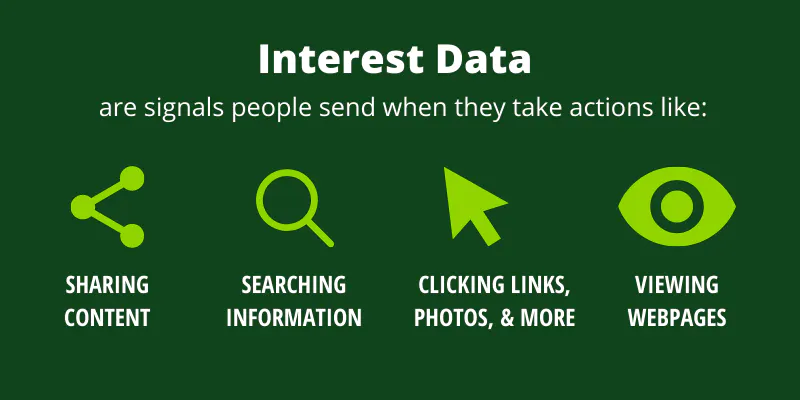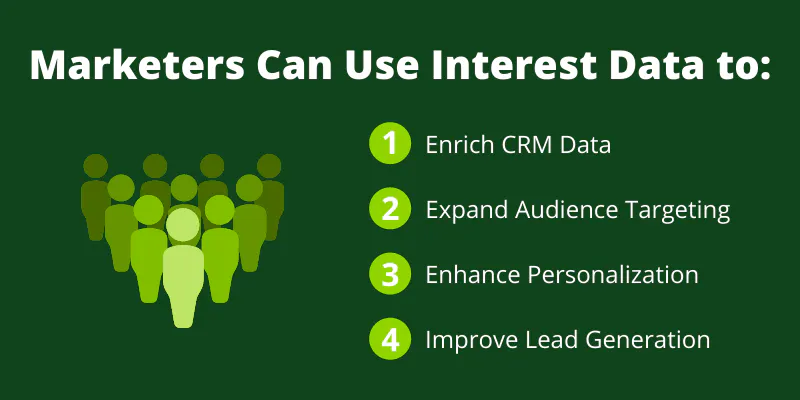What may have started as a prediction has evolved into a truism: The impending death of the third-party cookie is elevating the importance of first-party data. It makes perfect sense.
The data that marketers collect directly about their customers through their websites, mobile apps, or social media platforms is highly valuable. It includes shopping, spending and demographic information. It’s even privacy compliant since consumers share it with their implied or active consent.
Yet, the truism leaves out a pretty big consideration. There are limits to using first-party data alone since the information only illustrates a partial picture of a customer. It doesn’t provide key nuances that can help marketers create compelling messaging and effective customer journeys.
Brands can get those key insights by augmenting first-party data with real-time interest data.
What is Interest Data and How is it Gathered?
The marketing ecosystem is full of terms that are hard to describe. Interest data isn’t one of them: It’s simply information about what interests people.
People send signals about their interests when they take actions like:
- Sharing content
- Searching
- Clicking on content
- Viewing web pages
The Best Interest-based Data is Captured in Real Time and Across Devices
Marketers need fresh intelligence to meet customers at the right time with the right message. Data recency is critical when time is of the essence. Consider these factors:
- Many paths to purchase have accelerated. Supply shortages are causing car buyers to make decisions quicker, for example. A recent Cox Automotive study found buyers spent just under 12.5 hours researching and shopping for a vehicle in 2021, down 46 minutes from 2020.
- The needs of some target audiences change quickly, like those of expectant moms or engaged couples.
- Health concerns by their nature are timely.
Real-time interest data is also valuable when purchases have longer sales cycles. It can help marketers understand where a customer is in the buying journey. They can learn a prospect has moved from the awareness to consideration phase, for instance, which enables them to tailor their messaging appropriately.
Real-time Interest Data Has High Accuracy
This category of data is also attractive because it’s deterministic, meaning it’s based on information that is accurate because it’s provided by a person. Video game purchasers who share content about their new games to their social networks are telling the world they’re gaming fans.
How Marketers Can Use Real-Time Interest Data
We see four major use cases for layering real-time interest data onto first-party data:
- CRM data enrichment: First-party data only provides marketers with a slice of understanding about a customer. Having deeper knowledge of that person’s interests can help make their profile more holistic and, in turn, actionable.
- Expand targeting campaigns: Scale is a primary limitation of first-party data, but marketers who can access the passion points and cross-interests of customers can expand their audiences.
- Say a bank wants to reach parents of young kids to promote college savings accounts. Based on data it has collected, it likely knows that certain parents definitely have young kids. It can use interest data to find other customers who do as well. Customers who are searching for ratings of elementary schools, sharing content from children-related retailers, and researching kid-friendly foods could be great targets for a campaign promoting college savings accounts. Likewise, marketers who discover that their customers cross-index for beauty and fitness-related interests can use this intelligence to serve customized ads to a larger audience.
- Improved personalization: Marketers can struggle to personalize campaigns based solely on first-party data. That’s a pain point since it’s so critical today to create tailored messages for online and CTV advertising, websites, social media and email.
- Using real-time data can help marketers customize experiences and messages based on user interests. For instance, a financial firm can send relevant information to customers who have a validated need for a service or product at a time when interest is high. It can send college-related content to some audiences, tips on buying a home to another group, and retirement-focused stories to a third segment.
- Tailored lead generation: Marketers can’t gain a holistic view of a customer’s buying journey if they only analyze the interactions that person has with their brand. Having such limited information means marketers can’t effectively address users’ timely needs across channels. It can also hamstring the lead scoring efforts of B2B marketers.
Real-time interest data can help marketers better understand where users are in their paths to purchase and improve the accuracy and scale of lead scoring.
Marketers are recognizing the value that interest data–which may be referred to as intent data in a B2B context–can bring to lead gen efforts. A 2022 study from Demand Gen Report found:
- 30% of surveyed B2B marketers say leveraging intent/signal data to identify new opportunities is “important” and 18% say it is the “most important.”
- 31% say they plan to test and/or deploy intent/signal data to help accelerate their demand gen strategies in 2022.
- 47% say they are using intent data to better assess prospects who are actively researching a buying decision.
There’s clearly a lot of upside to enriching first-party data with real-time interest data from digital destinations. As marketers reduce their reliance on the third-party cookie, this powerful data duo can help brands get a more comprehensive view of customers and their purchase journeys.






